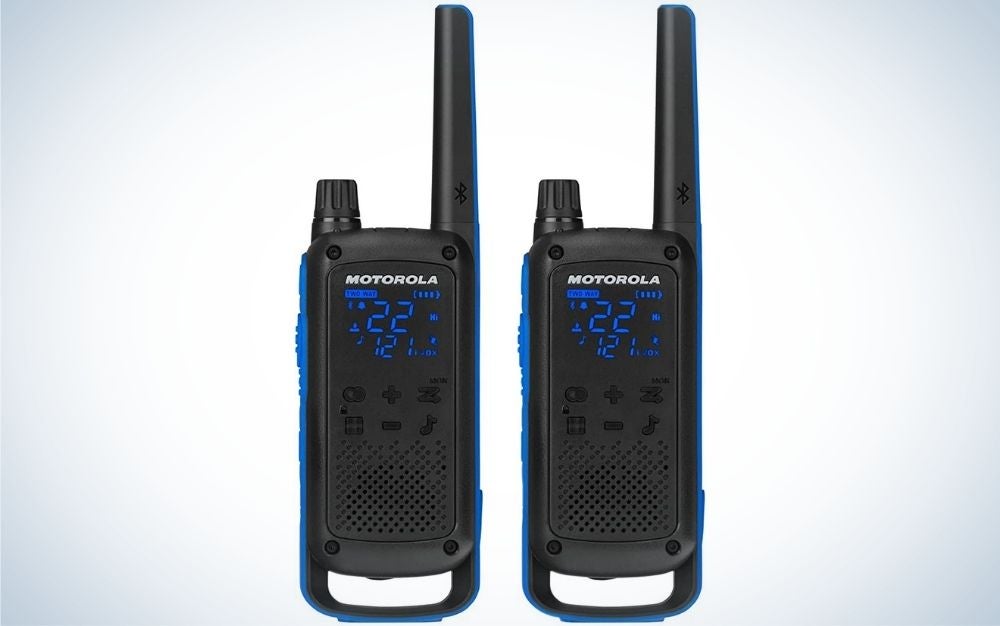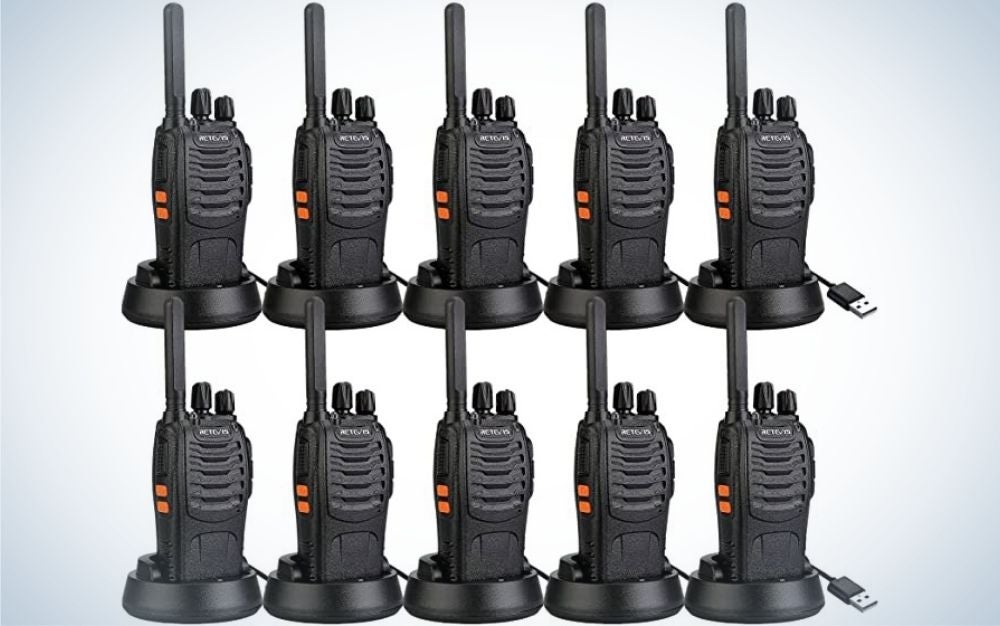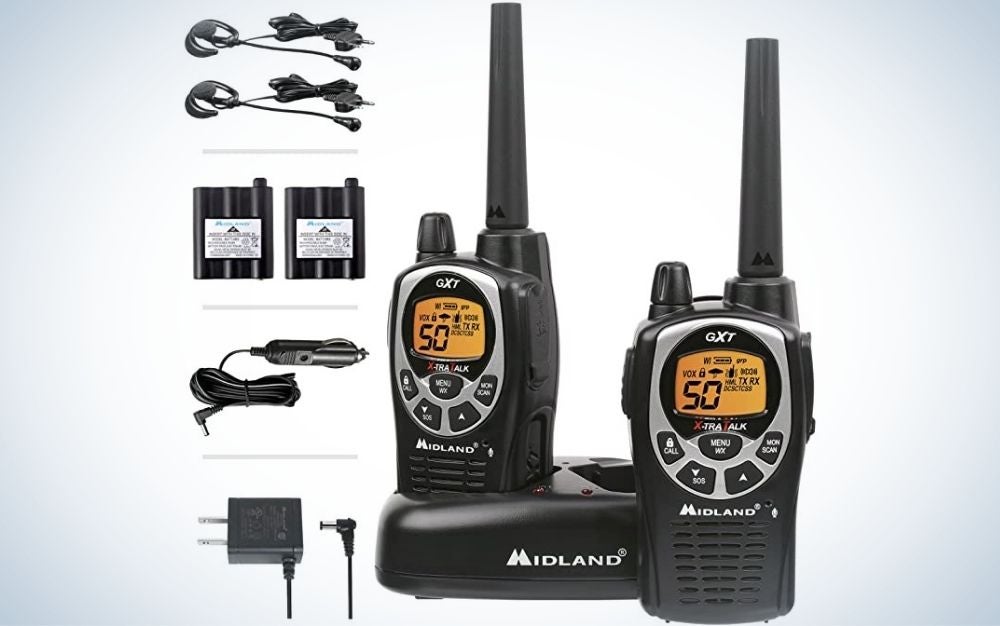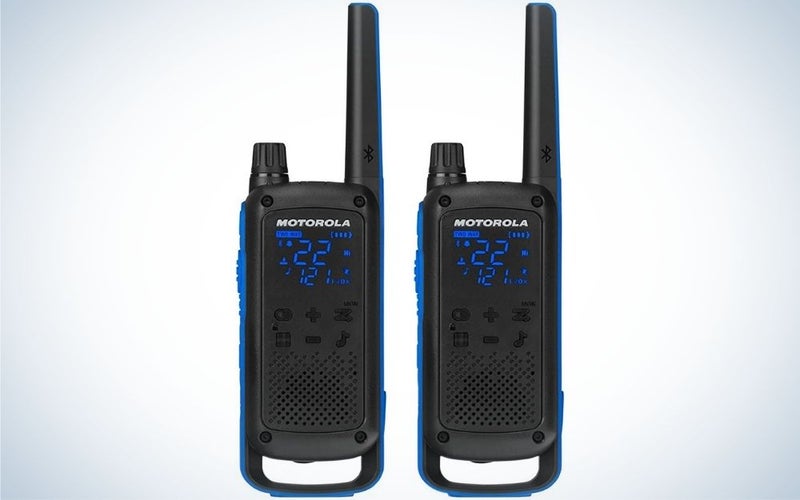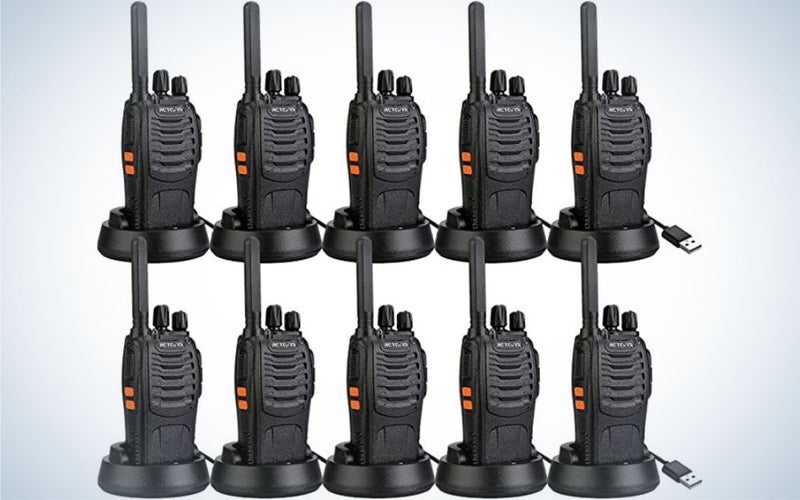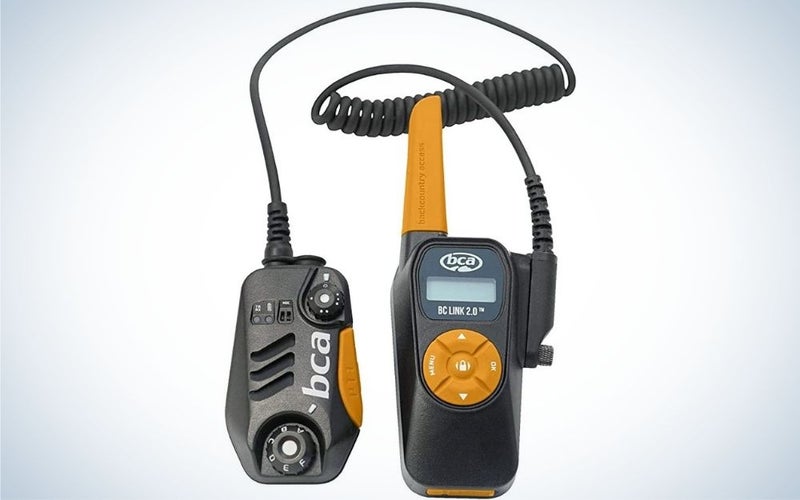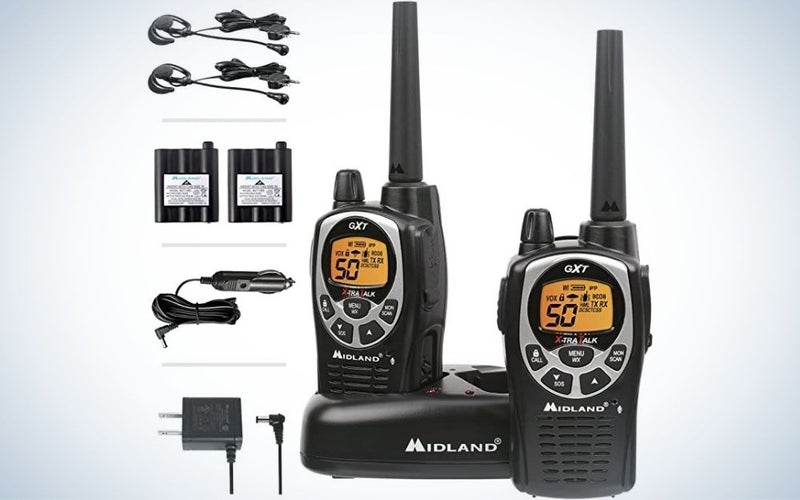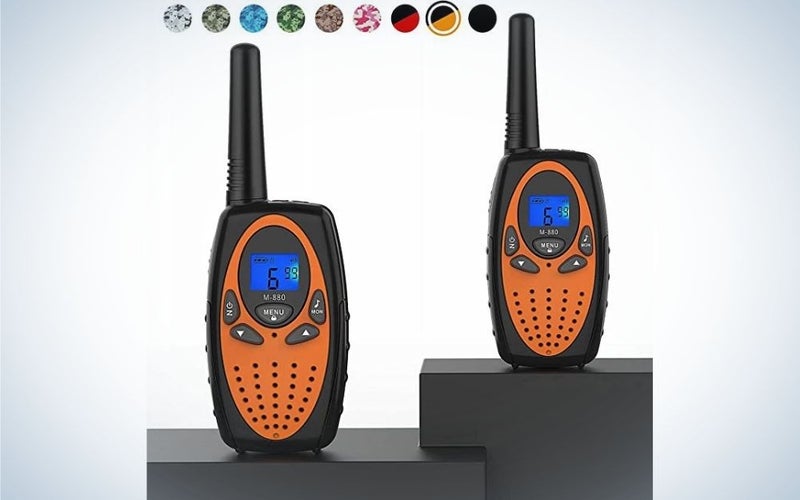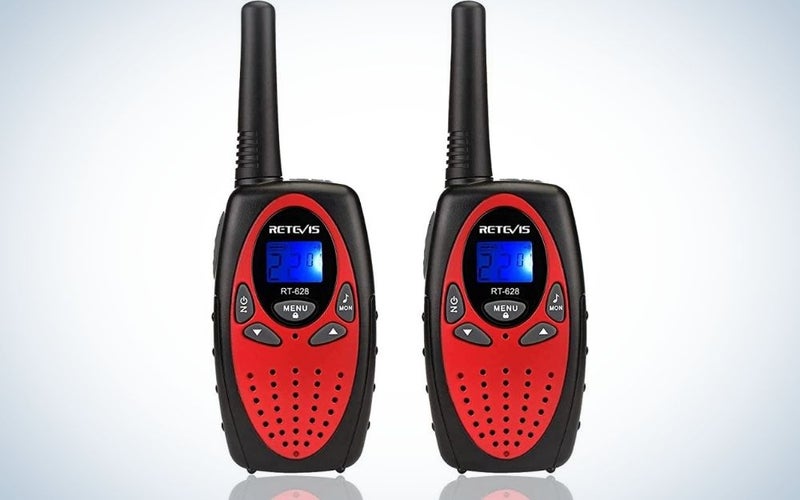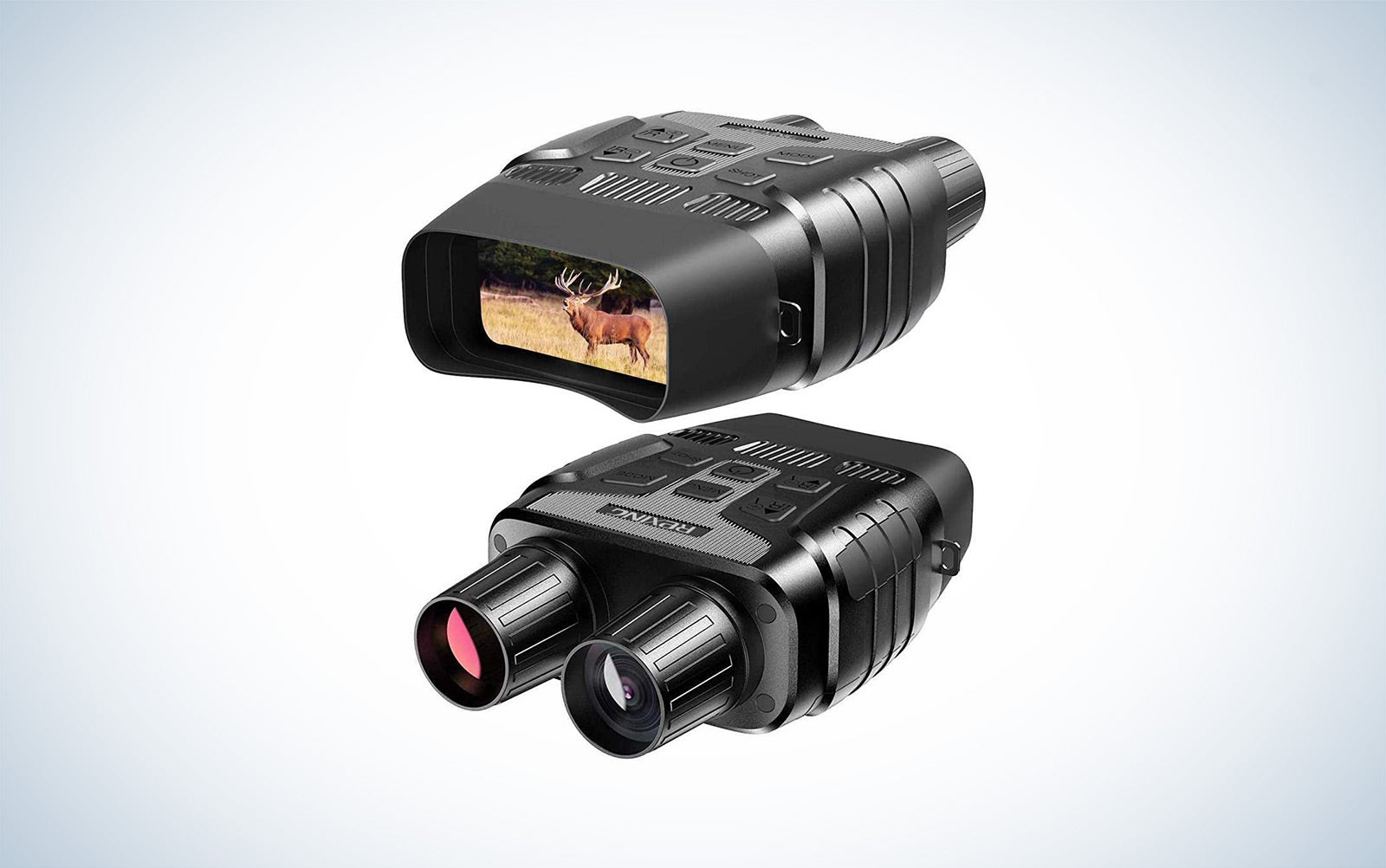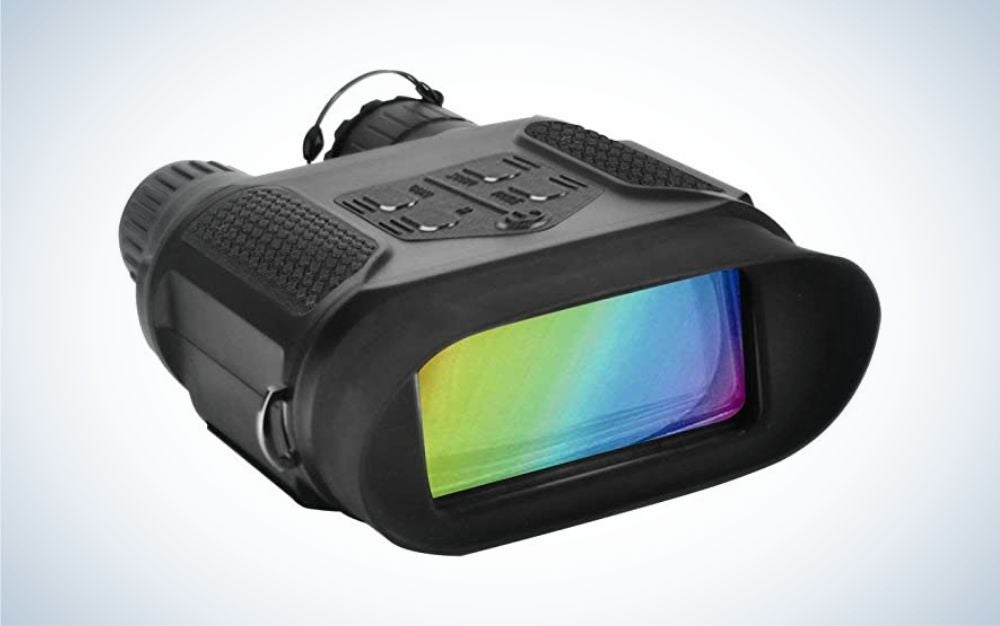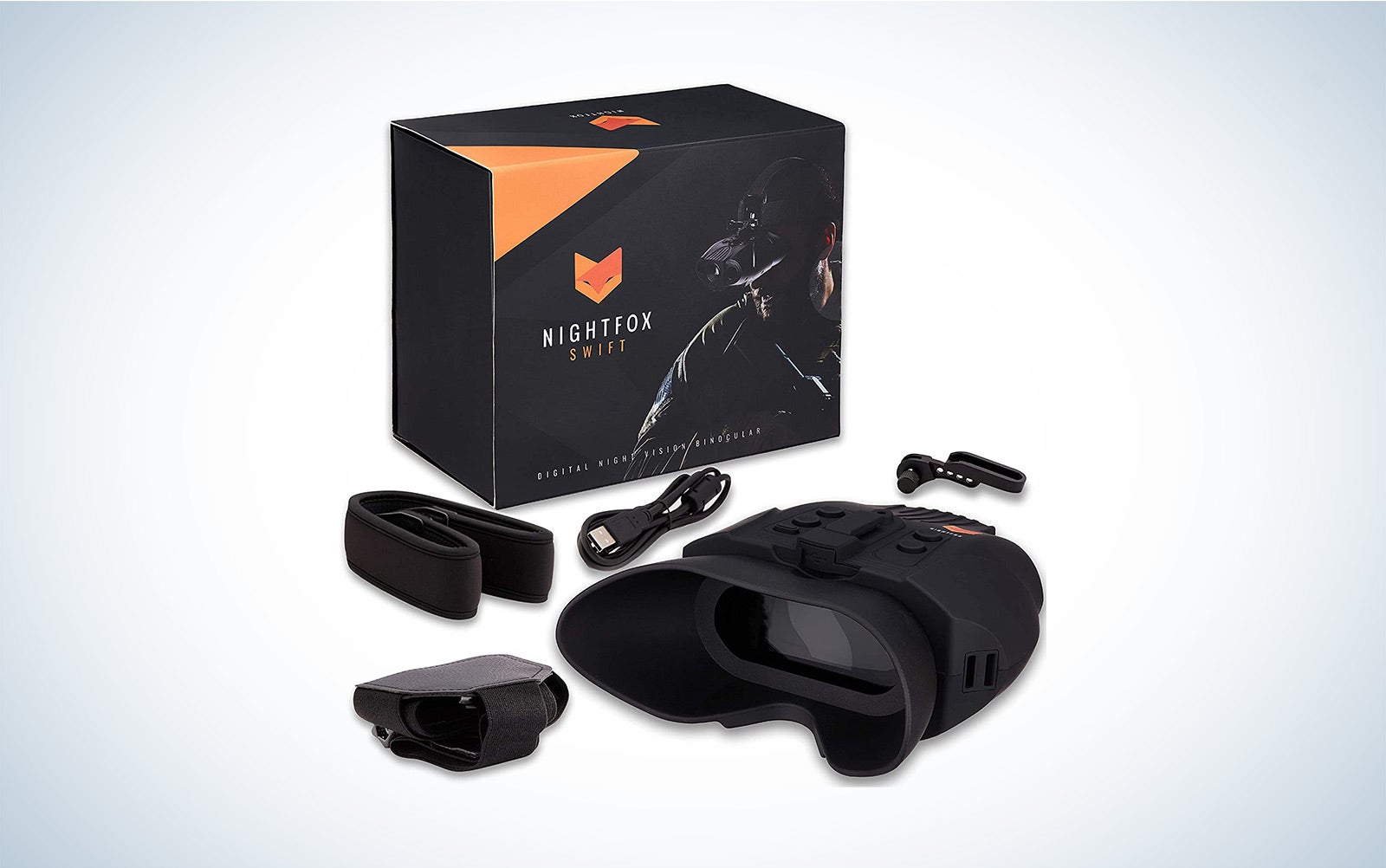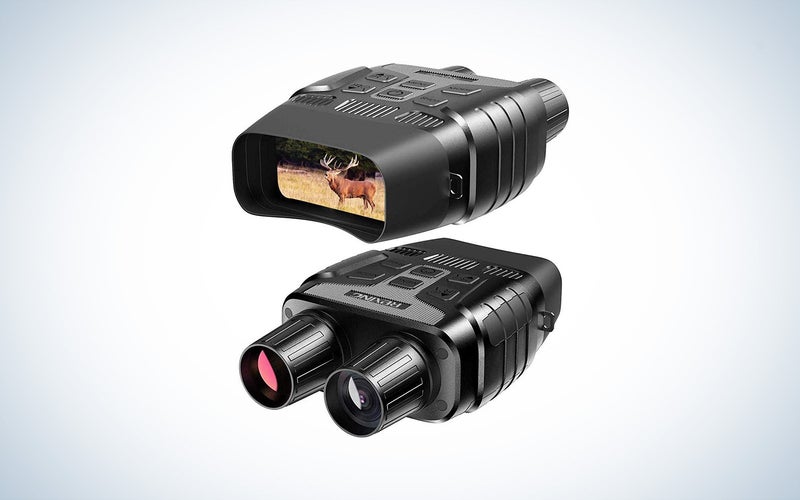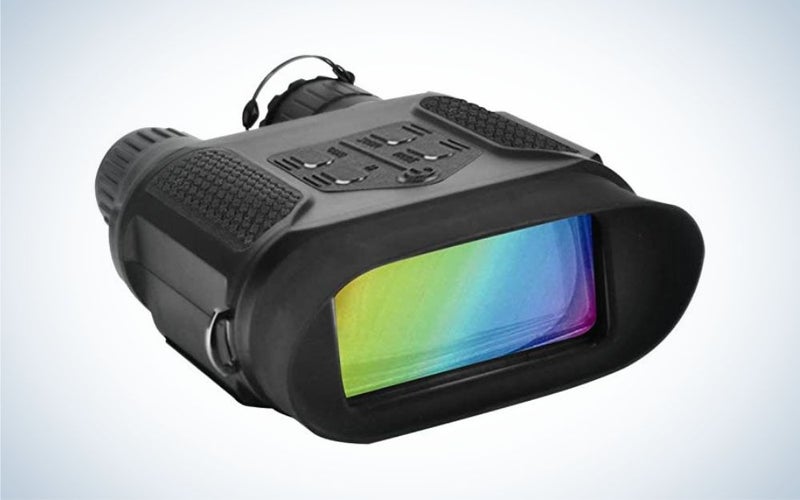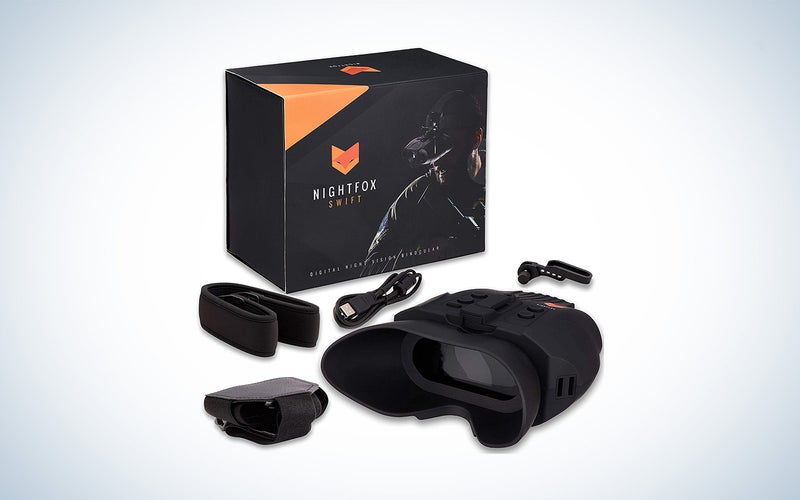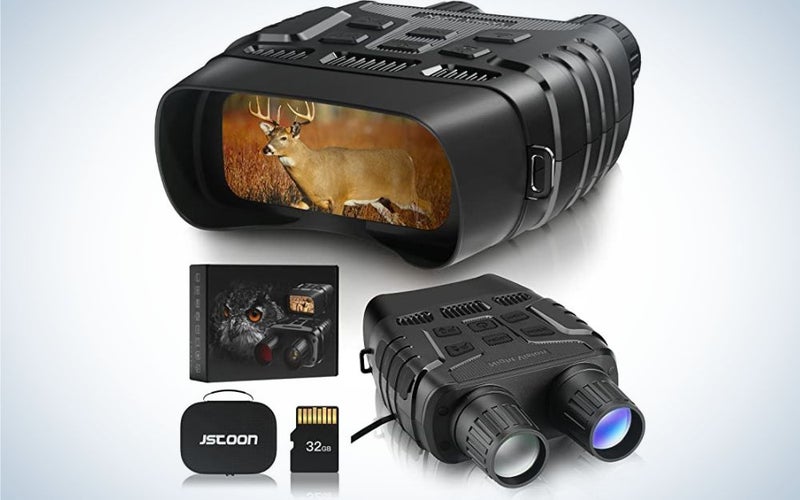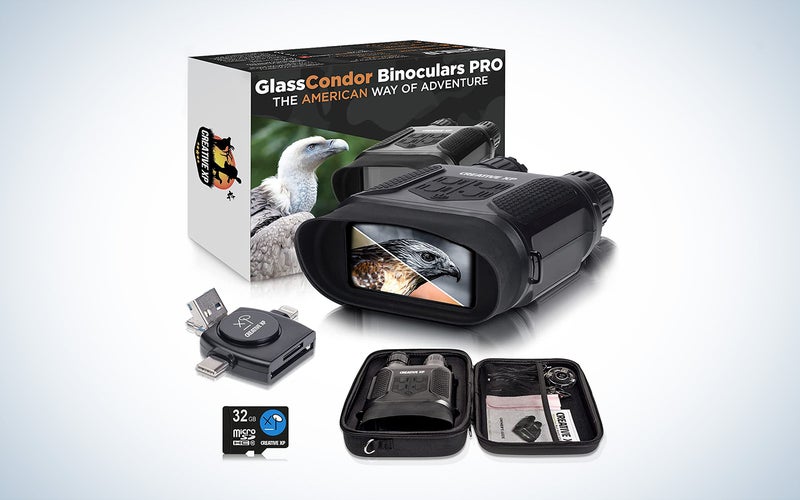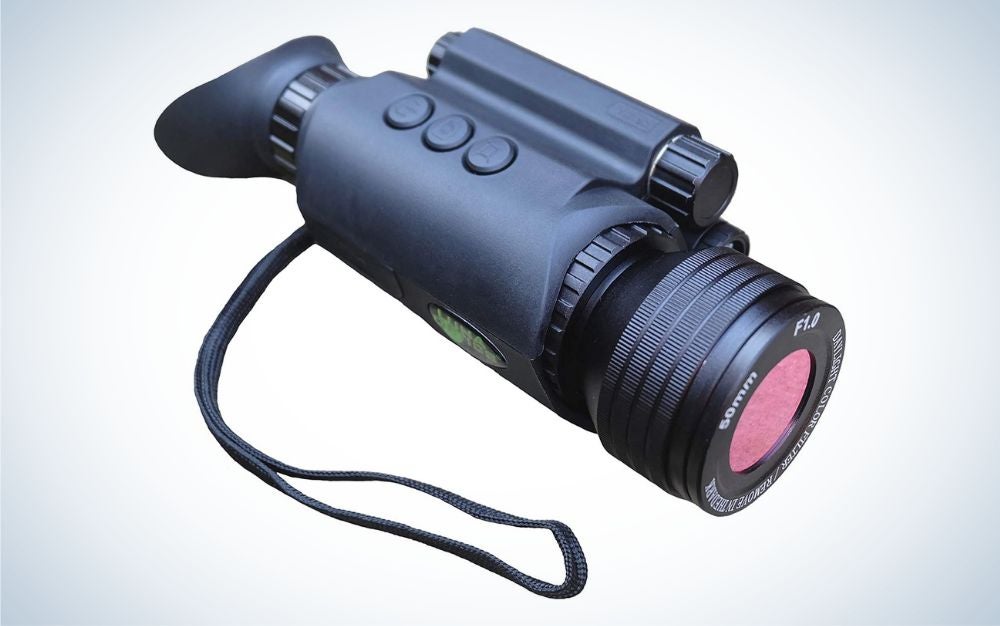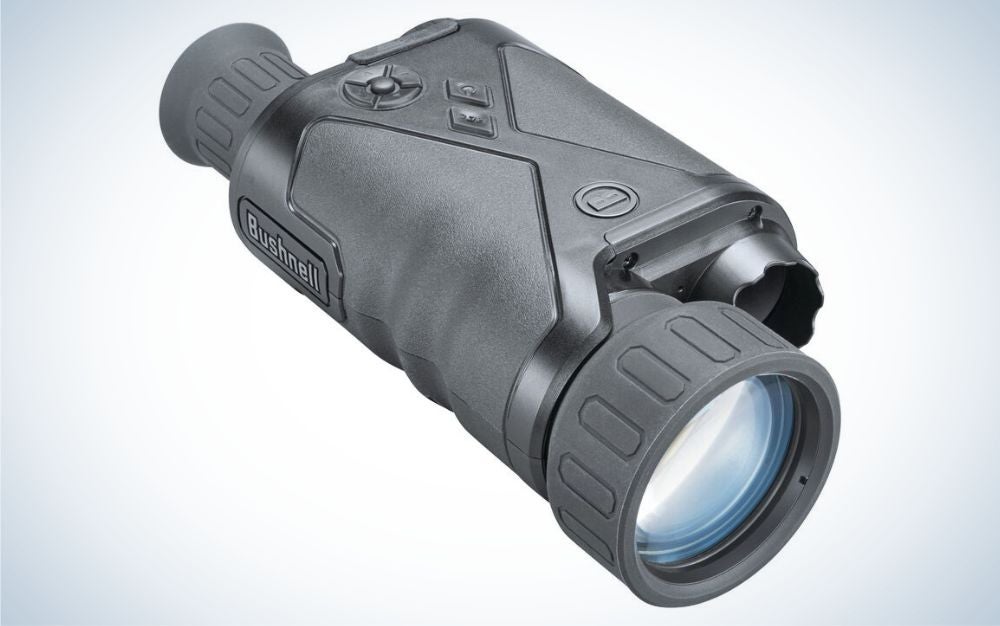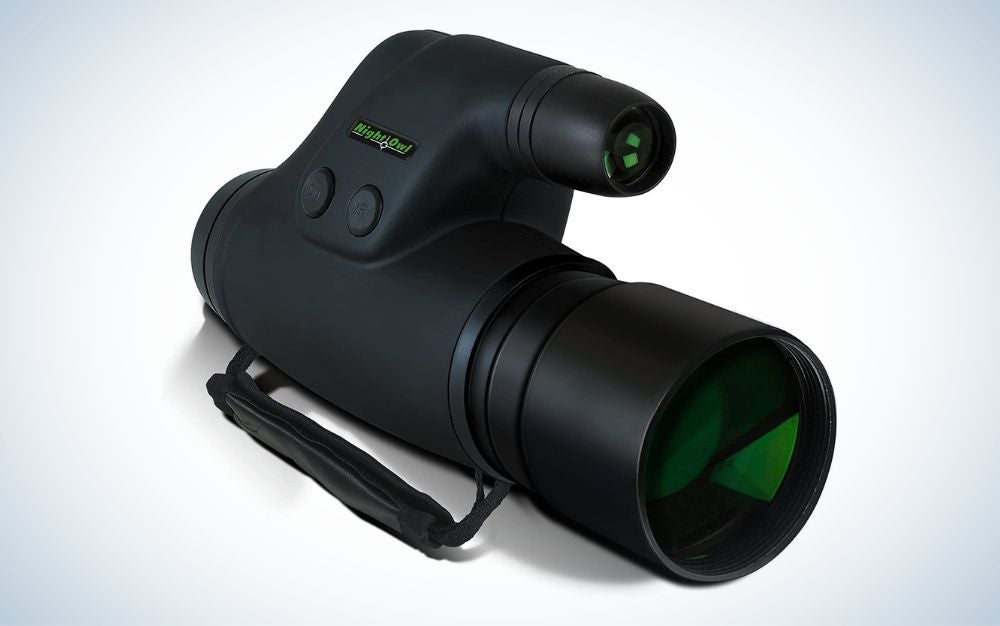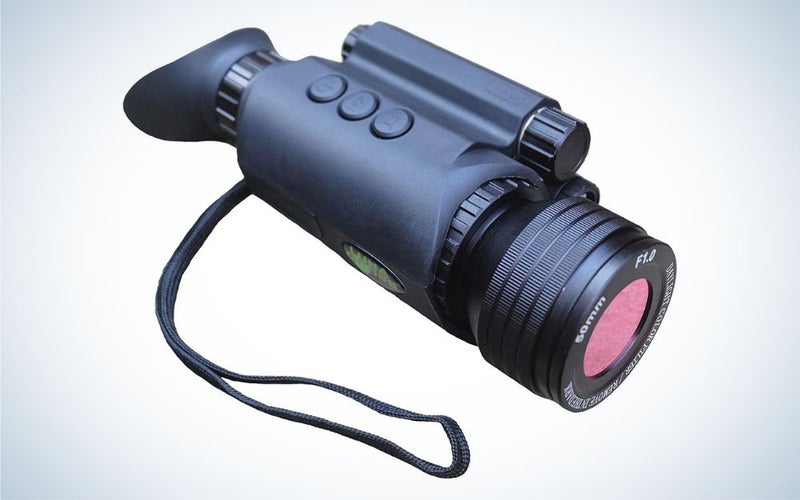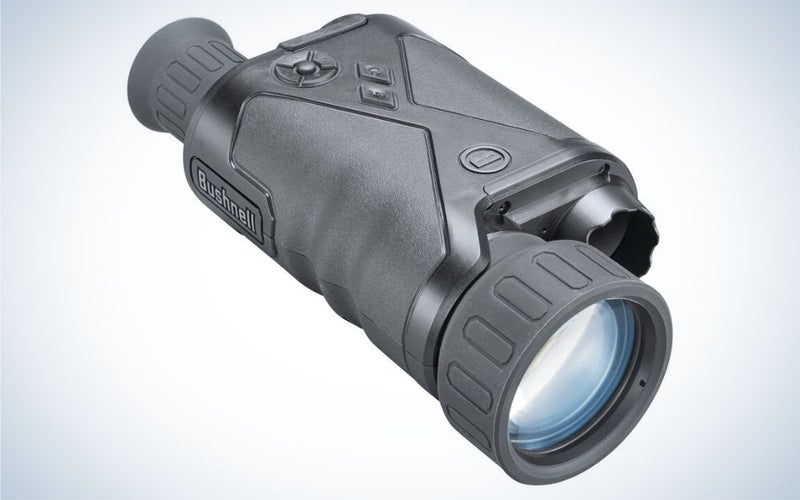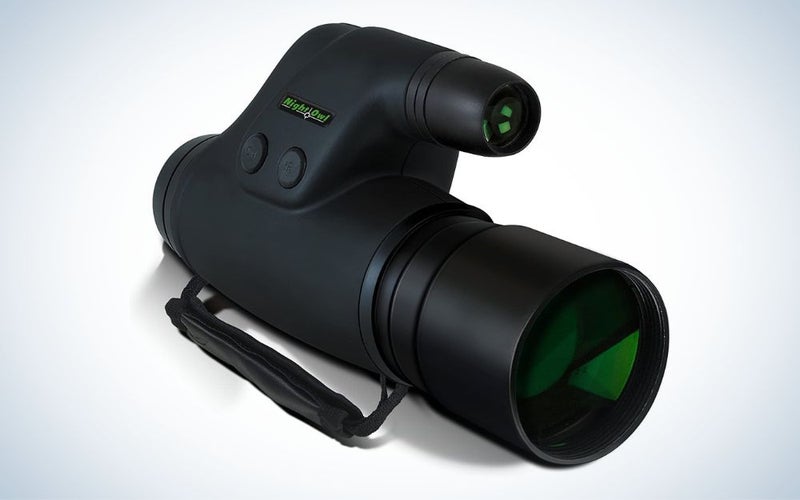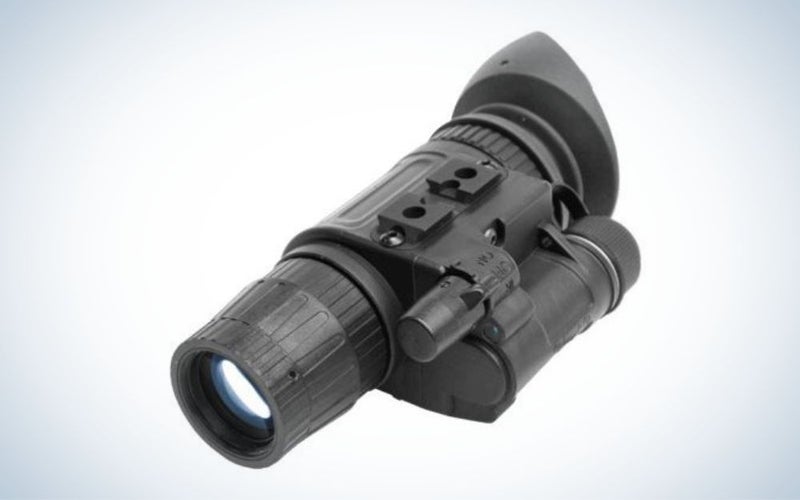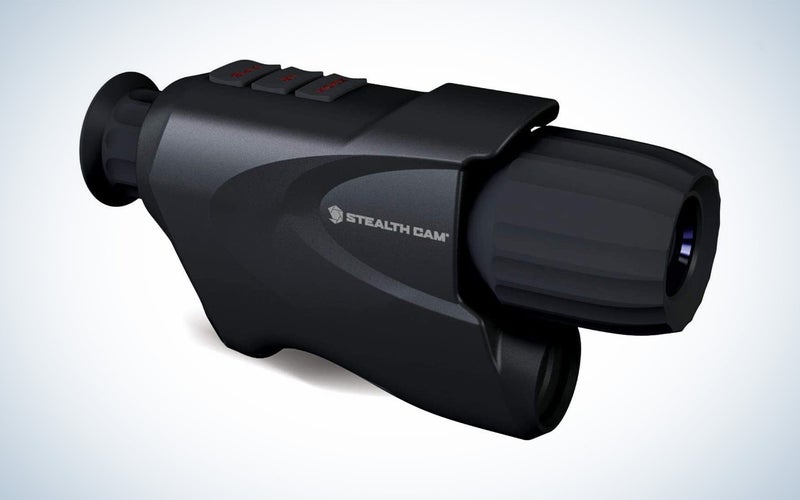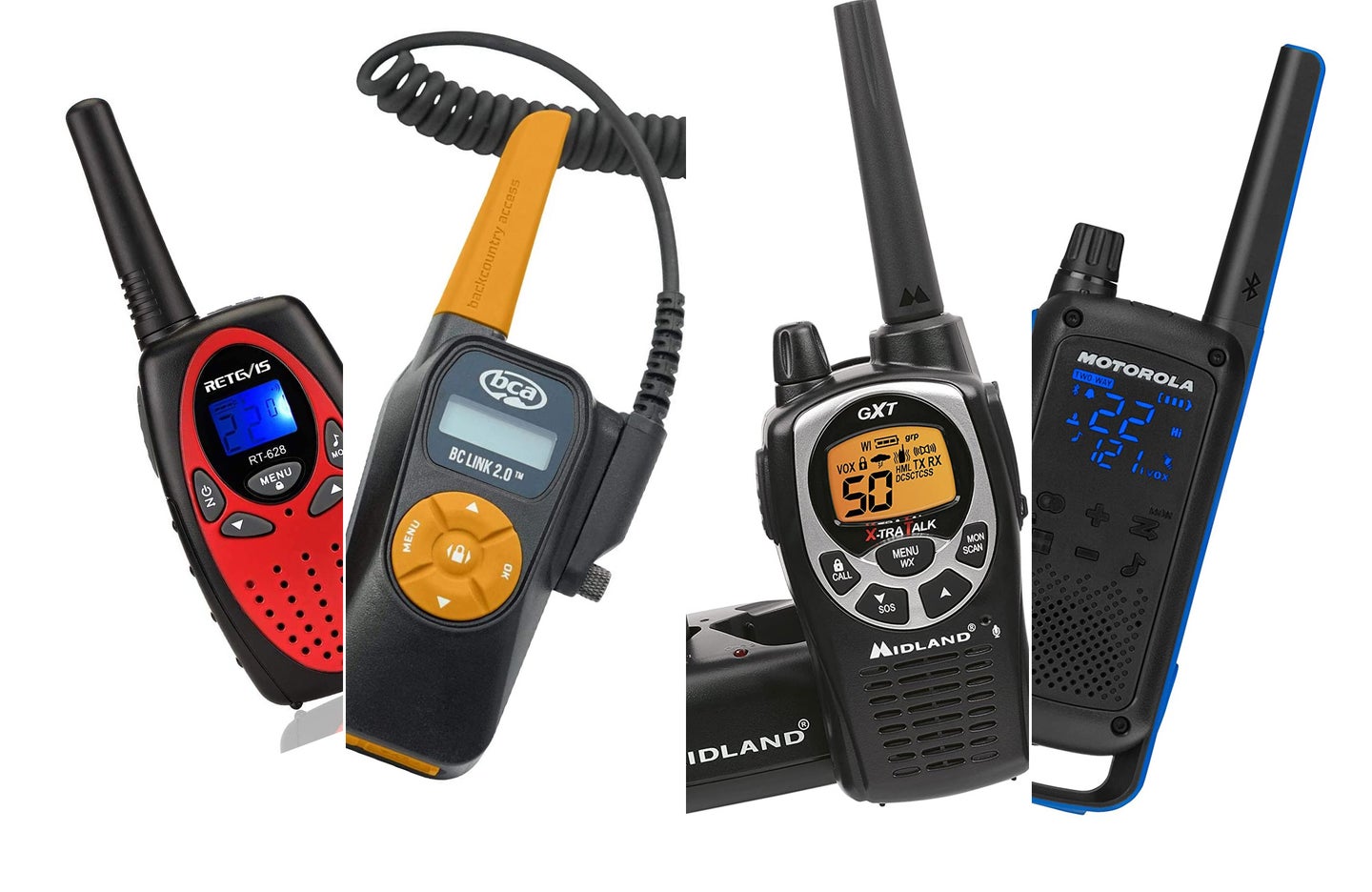
Staying in touch without the need for a phone can be useful on-set or in the wilderness.
The post The best walkie talkies in 2023 appeared first on Popular Photography.
]]>
We may earn revenue from the products available on this page and participate in affiliate programs. Learn more ›
Even if you have a cellphone, there are still plenty of opportunities for a good walkie talkie in your life. Maybe you’re someone who likes to go outside hiking and camping and wants to stay in touch with your group outside of cell service, you work in a busy warehouse or restaurant where communication is key, or you just like the ease of one button communication. They can also come in handy on film sets and other production environments where quick comms are key. Whatever the reason, getting the best walkie talkies can quickly and easily improve your communication, and it doesn’t hurt that no matter who you are using them is just fun.
- Best overall: Motorola Talkabout T800
- Best for professionals: Retevis H-777
- Best for mountains: Backcountry Access BC Link 2.0
- Best value: Midland GXT1000VP4
- Best for beginners: Topsung M880 FRS
- Best for kids: Retevis RT628
How we chose the best walkie talkies
I just went through the process of walkie talkie research and purchase before a cycling trip through Death Valley where I wanted to be able to talk to friends in a support car.
Our process considered a wide range of products from a number of reputable manufacturers. We scoured the web for professional reviews, reader feedback, and spec comparisons to go along with personal experience and knowledge. We focused on models that offer rugged build quality, high-fidelity sound, and reliable connectivity. We also considered elements like battery life and additional features.
The best walkie talkies: Reviews & Recommendations
With the crucial features and specs out of the way, it’s time to get into our list of the best walkie talkies. While we have split these up into individual awards for specific users, there’s also a lot of overlap when it comes to functionality and usability. So, be sure to check the entire list before committing to any one model.
Best overall: Motorola Talkabout T800
Motorola Solutions
Why it made the cut: A solid combination of features and price make these a solid all-around choice for a wide variety of users.
Specs:
- Channels: 22
- Range: Up to 35 Miles
- Waterproof: IPX4 Water resistant
- Battery Style: AA or included rechargeable battery
- Battery Life: Up 14 hours rechargeable
- Weight: 7.5 oz
Pros
- Streamlined, elegant design
- Easy to use buttons, even in the dark
- Data/messaging Transmission
- Battery flexibility
Cons
- Not waterproof
- Actual range may not meet projections
- Weight
The T800 is a powerful, feature-laden walkie talkie that is often available in a pair for under $100. We love the flexibility to use the included rechargeable batteries or to supplement with just 2 AA batteries. This gives both the environmental advantage, and a lightweight backup plan.
This model is well-regarded for its streamlined design and easy-to-use buttons. It’s not fully waterproof, which isn’t surprising at this price point, but with the included NOAA emergency weather channel and alerts you’ll be able to know if any big storm is coming through, and keep your electronics out of the elements.
What truly sets the T800 apart, though, is the Motorola app that you can run on your phone to pair with the T800. With the T800 and a phone with the app pre-downloaded, you can send GPS location between walkie talkies, even when you are not in the range of a cell tower. The app also lets you track the other T800s in your group on a map and send text messages between them and their apps. Of course, you’ll need an accompanying smartphone to get value out of all of these features.
Its reasonable price and broad feature set make this a winner for a wide variety of users.
Best for professionals: Retevis H-777
Retevis
Why it made the cut: This is a great solution for groups looking to stay in touch on a regular basis of a shorter distance.
Specs:
- Channels: 16
- Range: 2.5 miles
- Waterproof: No
- Battery Style: Rechargeable
- Battery Life: 12 hours
- Weight: 5.5 oz
Pros
- Affordable communication for large groups
- Built in flashlight
- Good sound quality within range
Cons
- Limited range
- Build quality
- Not water or weatherproof.
If you’re trying to communicate with many disparate groups or individuals, like across a camp or construction site, these Retevis walkie talkies are an affordable option. This is a no frills radio that saves cost by avoiding a light up screen and instead relies on two simple knobs for channel and volume control.
The walkie talkies are relatively light and compact but their limited range means you won’t want to use them in challenging outdoor circumstances, but they’re great for more urban environments like restaurants or theaters. The included rechargeable batteries work all day and recharge easily by USB when placed in the included docks.
Some users complained about long term durability, and depending on the environments you are working in, you may want to find something that is fully waterproof. These come equipped with a small light, which could come in handy in a pinch.
Best for mountains: Backcountry Access BC Link 2.0
Backcountry Access
Why it made the cut: These rugged radios can endure serious punishment without failing.
Specs:
- Channels: 22
- Range: 40 miles
- Waterproof: IP56 Water Resistant
- Battery Style: Rechargeable
- Battery Life: 22 Hours
- Weight: 11 oz
Pros
- Durability in extreme environments
- Impressive range
- Included handset
Cons
- Expensive
- Heavy
If you’re heading outside, not just for a hike, but high adventure activities like climbing, ski touring, or mountaineering, you’ll want a walkie talkie like this.
This walkie talkie can endure the outdoors. It’s so robust, in fact, that many users found it exceedingly heavy and a bit cumbersome. Thankfully you can store the radio in your bag and use an external handset clipped to a strap to listen and talk to others on your channel.
If the weather gets messy, like a big snow storm, the Backcountry Access has good water resistance and an interface that is simple to use, even in gloved hands, thanks to dial for volume and channel, large, simple, buttons.
Many users appreciated the strong signal and impressive range that were capable of maintaining a clear signal in bad weather across a big distance, even up and down mountain faces. And if you’re out there for a long day, the extremely impressive battery life will have the radio going with you the whole time.
Of course, all this comes at a cost, not only the hefty 11 oz, but the price tag as well. Especially when you consider that this radio is sold not in pairs, but individually. But when you need a communication beast for a beast of a day, this is what should be at your side.
Best value: Midland GXT1000VP4
Midland
Why it made the cut: They offer a long range and solid features for less money than you might expect.
Specs:
- Channels: 50
- Range: 36 miles
- Waterproof: JIS4 waterproof
- Battery Style: Rechargeable or AA
- Battery Life: 9 hours rechargeable battery
- Weight: 4.8 oz
Pros
- Good range
- NOAA weather alert notifications
- Bright LCD
Cons
- “Waterproof” a loose term
- Can be overwhelmed by features
This midland radio is for the person who wants good performance and range, and access to a whole bunch of features. If you want simple, elegant operation, this is a great choice.
Their impressive range and number of channels, especially for the price, make them a great option for those working in large open outdoor areas, or during outdoor emergencies. If you are coordinating with a large group of many users, you can even program different call tones so you know who in your group is calling.
These are a handy tool, but not just for communication. They also have NOAA alerts for severe weather, SOS siren alerts, and locator signals. While we love the features, navigating through them can get cumbersome.
The waterproofing rating comes from the Japan industrial Standards scale so it might not be as waterproof as you think. While it will work if it is splashed with water, don’t submerge it in liquid and expect it to keep communicating.
Best emergency prep: Topsung M880 FRS
Topsung
Why it made the cut: Get basic features and a three-mile range with very little fuss.
- Channels: 22
- Range: 3 miles
- Waterproof: No
- Battery Style: Three AA batteries
- Battery Life: Battery dependent
- Weight: 2.9 oz
Pros
- Affordable
- LCD Screen for night use
- LIghtweight and small
Cons
- Cheap feeling construction
- Limited Range
- Battery type and number
This walkie talkie is beloved in online stores where customers laud its affordable price and simple operation.
The range is limited, but for situations just out of earshot, like in different rooms within the same building or in a caravan of cars, they work well.
The operation is simple, though many complain that it is tough to understand the instruction manual. Once you figure it out though, it’s hard to forget. The interface relies on easy to push buttons and an easy to read screen, thanks to a light up LCD. AA batteries, and three of them, makes it great as a backup communication device that you can use occasionally and store with fresh batteries.
This is not the radio for pushing the limits or communication over large distances. It’s a cheap solution for communicating with someone just out of earshot.
Best for kids: Retevis RT628
Retevis
Why it made the cut: They’re simple and cheap enough that it won’t hurt when one breaks or gets lost.
- Channels: 22
- Range: 1 mile
- Waterproof: No
- Battery Style: AA
- Battery Life: Battery dependent
- Weight: 3.25 oz
Pros
- Multiple colors
- Price
- Channel lock to stay on the same channel
Cons
- Battery style
- Range
- Durability
Not only is this walkie talkie set exceedingly affordable, but the buttons and walkie talkie body are small and lightweight to fit well in a child’s hands.
Parents will love the channel lock features, which helps keep the radio on the right frequency and from moving onto the wrong channel after fumbling from children’s hands. They’ll also love the price point, which won’t have you pulling your hair out if one of the walkie talkies disappears in the backyard or under a car seat.
The range is just over a mile and is really best for recreation or when the stakes are low, like communication from one side of the neighborhood to the other. Because of this, it is really closer to a toy than a major communication device.
What to consider when shopping for the best walkie talkies
Though many of the best walkie talkie models offer similar bodies or shapes, the internal technology be far different. Knowing how you will use your walkie talkies, where you’ll be, and how long you need them to work will help lead you to the system that will fit you best. Here are a few things to consider, and measurables to look for while you’re shopping.
Price
No matter what you’re buying, price is a good marker of how serious the tool is, and how long you hope to use it for. Knowing how you’re going to use your walkie talkies will help you save money in the right ways. Know what you need, and only by as much as is required to comfortably meet that need.
It’s worth investing in a stronger walkie talkie if you are relying on it to save your life, rather than just trying to avoid running up and down the stairs to tell your spouse which breaker turns off the lights in the kitchen.
Battery and battery life
You’ll have to decide whether you want a model that relies on a rechargeable battery or disposable cells that need replacing once they’re spent. Often rechargeable models will be more expensive, but they do come with the added benefit of creating less waste and not requiring sometimes expensive disposable batteries.
If you need your walkie talkies to work for many days away from civilization, disposable batteries can give you the option of bringing a lightweight backup charge.
While it is often possible to find accurate battery life estimates for rechargeable batteries, battery life for AA or AAA powered walkie talkies can be much more difficult as these batteries are not all created equally. If you do rely on disposables, opt for the higher-end models from reputable brands if you want them to last.
Range
Range determines how far the walkie talkies can communicate with each other. The power of consumer level, or Family Radio Service, walkie talkies is limited, which means you won’t be talking across scores of miles like you might with more professional radio that requires a license. While manufacturers can give you a sense of range, all radios will be affected by things like topography and weather.
The models on this list can communicate with a maximum range of just 1 mile up to nearly 50 miles, so be sure to get something that covers the distance you need.
Channels
Channels are like different rooms along the radio wave that you can pop into for a more private conversation. The more channels you have access to, the more likely you are to find a channel that no one outside of your party is using. This will help you communicate more relatively privately without being interrupted by strangers.
Similarly, having multiple channels means you can switch channels on your radio to communicate with different members of your party if you are trying to keep communication less cluttered with fewer people on the same line.
Durability and weatherproofing
Some walkie talkies are better suited to harsh elements like rain, sea water, and big falls than others. Determine whether yours is going to live in the car, at home, or in more robust outdoor environments that will require better protection.
If you don’t need fully waterproof, don’t spend the money on it. But if you suspect there is a good chance you could drop a walkie talkie in the water, especially in a moment where you might need it most, don’t settle for water resistance.
Features
Are you looking for simple one-button communication? Or do you need a more robust survival tool with other reception and transmission capabilities? Some walkie talkies come with weather alert radios, SOS features, and even data transmission. All of which can be extremely useful, or annoying if they just get in the way.
FAQs
Q: How far can walkie talkies reach?
Typical walkie talkies like those on this list will cover up to roughly 50 miles of range. Of course, that range can vary depending on your specific conditions and location. If you’re trying to send a signal through a mountain or a bunch of buildings in a city setting, that range could shrink significantly.
Q: What’s the difference between walkie talkies and marine radios?
Marine walkie talkies, or VHF radios work great, especially with low energy over long distances, but they are only allowed on the water. In most cases it is actually illegal to use them on land. If you’ll be on the open water, interacting with large commercial vessels, check your local laws, and invest in a marine radio, and if you have one already, leave it in the boat and buy a walkie talkie for hiking.
Q: Do you need a license for walkie talkies?
If you’re looking to upgrade from walkie talkies, there are a few options, like General Mobile Radio Service (GMRS) which require an FCC license, or Citizens Band Radio Service (CB) which have dedicated rules for operation as defined by the FCC. When upgrading, be sure to know how your radio works, what guidelines it falls under, and that you are following all laws and licensing regulations as the penalties can be fines and even imprisonment.
Final thoughts on the best walkie talkies
- Best overall: Motorola Talkabout T800
- Best for professionals: Retevis H-777
- Best for mountains: Backcountry Access BC Link 2.0
- Best value: Midland GXT1000VP4
- Best for beginners: Topsung M880 FRS
- Best for kids: Retevis RT628
Walkie talkies are an incredible tool, and a whole lot of fun. Knowing what you need out of them and how often you’ll use them will help you get the one you need. Be it simple and clear communication, or cutting-edge tech and information. The walkie talkie can be as simple or modern as you like, but whatever you choose, have fun, and be safe.
Why trust us
PopPhoto has a long history of delivering the opinions of some of the sharpest and most prolific camera dorks the world has to offer. Since 1937, we’ve been reviewing cameras, providing wisdom from well-known photographers, and generally just nerding out about all that goes into making great pictures. Our current crop of writers and editors have decades of professional photography and camera writing experience among them. Collectively, we’ve probably shot with just about every camera and lens combo you can imagine—as well as some obscure stuff you may not even know about. Remember the Casio Tryx folding camera? PopPhoto does.
We also get that buying a camera is a big decision, which is why we’re dedicated to helping folks choose the right one (or, in our case “ones”) for their needs. Case in point: Handing over top dollar for an expensive rig may leave you unsatisfied if it doesn’t fit your preferred shooting style. Sure, a $6,000 sports-oriented DSLR can capture landscapes, but do you really need to do it at 30 frames-per-second? No, you don’t.
Related: Best camera phones
The post The best walkie talkies in 2023 appeared first on Popular Photography.
Articles may contain affiliate links which enable us to share in the revenue of any purchases made.
]]>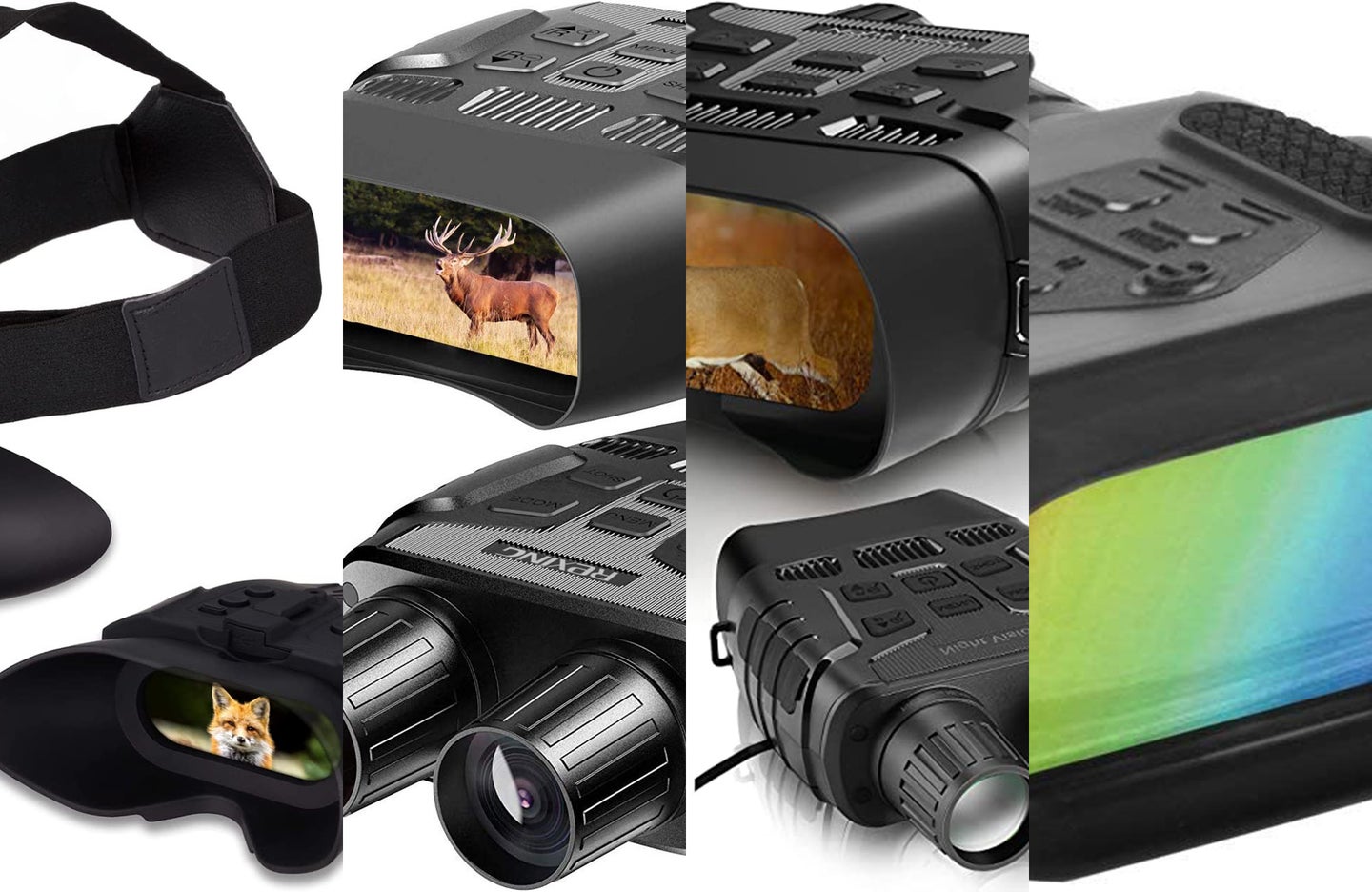
When the sun goes down, see into the night with these impressive night vision goggles.
The post The best night vision goggles for 2023 appeared first on Popular Photography.
]]>
We may earn revenue from the products available on this page and participate in affiliate programs. Learn more ›
A good set of night vision goggles can illuminate the darkness without letting others know you are out there. They can be helpful whether you are trying to identify an animal, secure your property, or just want to know what’s out ahead or above you in the night.
In the world of night vision, there are a few options, including night vision monoculars, which some prefer for their simpler structure that often comes at a lower price. But nothing beats a set of night vision binoculars for ease of use, natural view, and a wide field of vision. So when it’s time to see what others can’t, flip down or hold up your goggles and see into the night. Whatever you choose, here are the best night vision goggles and some things to consider before you buy.
- Best overall: Rexing B1
- Best for long-distance: Solomark Night Vision
- Best hands-free: Nightfox Swift
- Best video quality: JStoon Night Vision Goggles
- Best for surveillance: CREATIVE XP Night Vision Goggles – Pro
How we picked the best night vision goggles
We scoured the internet to find the best online resources, experts, expert reviews, consumer reviews, and recommendations for night vision goggles for all situations. From there, we collected an extensive list of some of our favorites. We compared them on a number of essential metrics, including cost, coverage, portability, durability, features, connectivity, and ease of use.
We then worked through each night vision goggle to find its strength and weaknesses and crucial metrics to help you find the night vision goggles that will work best for you and your needs, wherever you are in the world.
The best night vision goggles: Reviews & recommendations
Best overall: Rexing B1
Rexing
Why it made the cut: It offers great magnification and impressive battery life at an affordable price.
Specs
- Type of vision: Digital
- Magnification power: 10x
- Battery type: 6 AA
- Weight: 1.3 pounds
- Dimensions: 5 x 5.25 x 2.25 inches
Pros
- Weatherproof and water-resistant
- Impressive magnification
- Includes tripod mounts
Cons
- Not rechargeable
The Rexing B1 is an impressive set of night vision goggles, especially considering the price. These goggles provide 10x optical magnification and 4x digital magnification with an effective range of 300m. You can use one of seven IR settings to fine-tune your brightness as you look near and far. Though some might be unimpressed with the video quality, which comes in at 720p at 30 fps, it is still plenty for the price.
After recording night vision footage, you can play back what you capture on the 2.31-inch screen or use a cable to connect it to your computer or TV. And you’ll have plenty of footage. When used in the daytime, the 6 AA batteries can power these goggles for 17 hours, giving you access to the impressive zoom. In IR night vision mode, it will still last an impressive six hours.
These goggles are ready for whatever your mission is thanks to weatherproofing and IP56 water resistance, which means, while you won’t want to dunk these underwater, you won’t have to come in from the rain.
Best for long-distance: Solomark Night Vision
SOLOMARK
Why it made the cut: These have an impressive effective range, even without supremely high-quality video.
Specs
- Type of Vision: Digital
- Magnification Power: 7X
- Battery Type: 8 AA
- Weight: 2.2 pounds
- Dimensions: 12 x 10 x 5 inches
Pros
- Expansive 1300ft range
- Easy to use
- Day and night functionality
- Clear and bright LCD screen
Cons
- Requires a lot of batteries
- Lower quality video
This set of night vision goggles has an impressive 1300ft range with multiple magnification settings ranging from 3.5 to 7X, making it a great option for many who need long-range sight at night.
The infrared illuminator will light up even the darkest nights and make them easily viewable with the internal 4-inch viewing screen and the option to wire the goggles to an external viewing screen like a TV or computer. Some might not be impressed with the end video quality, though, as 720p with 30fps viewing can leave some images blurry.
These goggles are easy to use and adjust between three brightness and three IR settings. Or you can use them during the day with the IR fully turned off. To make things easier, it comes with a microSD card.
The Solomark has easy-to-hold grip surfaces, though prolonged use might be difficult as it requires a lot of batteries which adds considerable weight.
Best hands-free: Nightfox Swift
Nightfox
Why it made the cut: Thanks to the included head mount, they are hands-free, easy to use, and simple.
Specs
- Type of Vision: Digital
- Magnification Power: 1x
- Battery Type: Rechargeable
- Weight: 11.81 ounces
- Dimensions: 6.69 x 5.51 x 2.76 inches
Pros
- Hands free operation
- Lightweight
- Integrated battery
Cons
- Can be disorienting with long usage
- No magnification
The Nightfox Swift is a great entry-level product for those who want to see at night, especially in close range. But, unlike many other night vision goggles, these do not provide any magnification and have an admittedly limited effective range of about 75 yards. As a result, these are best for nearby viewing, like home security or moving through a dark area without needing to know what is far off in the distance.
You can use these goggles hands-free thanks to pre-equipped headgear. It lets your night vision easily move with you. Adjustments to brightness and IR levels are easily made with simple buttons on the rubberized goggle body. The overall user interface is intuitive and should offer most users few issues.
These goggles are rechargeable with about three hours of battery life. And they are smaller than most other options making them great for travel, so long as you have the ability to recharge them regularly.
Best video quality: JStoon Night Vision Goggles
JStoon
Why it made the cut: They offer great range with no need to buy a memory card.
Specs
- Type of Vision: Digital
- Magnification Power: 4X
- Battery Type: 6 AA
- Weight: 1.3 pounds
- Dimensions: 10.2 x 7.9 x 3.6 inches
Pros
- Comes with a 32 GB card
- Impressive image quality for the price
- Long range viewing
Cons
- Short battery life
These goggles have an impressive range and image clarity, with the benefit of surprising accessories included. They are great night vision goggles for those who need long range thanks to their effective distance of 984 feet in complete darkness. And you can adjust the IR emitter for variable light conditions, including daytime. With that distance, you will also get 960p 30 fps resolution video which you can export to a computer or TV with the included cable.
The 25mm objective lens is less impressive than some of the other night vision goggles we saw but still gets the job done. We have seen better battery life, though, as six AA only works for about six hours of operation.
These goggles offer manual focus and a 2.31-inch screen for easy and clear viewing and even come with a surprising addition of a 32 GB memory card and case. Unfortunately, though, this system is relatively large, so it won’t be ideal for holding by hand for long periods.
Best for surveillance: CREATIVE XP Night Vision Goggles – Pro
Creative XP
Why it made the cut: They provide excellent range, great zoom, and include a memory card.
Specs
- Type of Vision: Digital
- Magnification Power: 7X
- Battery Type: 8 AA
- Weight: 2.86 pounds
- Dimensions: 10.9 x 7.9 x 3.7 inches
Pros
- Comes with a 32 GB card
- Large viewing screen
- Impressive viewing range
Cons
- Less than impressive battery life
- Requires a lot of batteries
- Heavy
The Creative XP Night Vision Goggles offer an impressive viewing range of 1,340 feet thanks to its 31mm objective lens. Combine that with an IR illuminator and a 4-inch viewing screen, and you have long-range, easy-to-view images at night.
The Creative XP also features an impressive 2x digital zoom and 3.5-7x optical zoom which is easy to switch through thanks to the on-goggle zoom adjustment button.
With an IPX4 water resistance rating, it is ready for your outdoor adventures like hunting, night hiking, and scanning for potential predators or intruders. Though you’ll want to ensure the rest of your pack is light, as with eight batteries, these goggles aren’t lightweight. They have impressive visual performance, but using them will require a lot of batteries and strength to hold the associated weight.
Many will be delighted to find these night vision goggles come with a 32GB memory card for recording and storing what you see.
Things to consider before buying night vision goggles
There is a fair amount of technical jargon and numbers mentioned in the product information for night vision goggles. It can be confusing to know what everything means or what is relevant to you. Much of the information relevant to night vision goggles also pertains to choosing binoculars, so if you know those tools, you have a head start. Below are some of the most important things to consider before making your purchase.
Weight
If you are carrying this into the backcountry while hiking, hunting, or doing anything else that will have your belongings on your back, weight is an important consideration. Lighter tools are easier to carry, though that weight savings often comes at the cost of lower quality optics, fewer features, or worse battery life.
Size
Similar to weight, the size of your night vision device will dictate how likely you are to bring it with you. Smaller, more compact devices are easier to justify in the cramped space of a backpack or camp bag. However, if you use these at home or from your vehicle, this may not be as much of a consideration.
Magnification power
Night vision can not only light up the night but can often magnify your view like a pair of binoculars to give you a better view off in the distance. Greater magnification often comes at a higher cost and can sacrifice image quality. Some devices will offer digital magnification along with optic magnification, but just like expanding your fingers to zoom in with a phone camera, this often comes with a degradation of the image quality.
If you want magnification but decide you don’t need night vision abilities, pick from one of our favorite binoculars.
Battery power
Seeing at night requires power, and for most of these devices, you won’t be plugging them into the wall. Some night vision devices run on disposable batteries, while others have built-in rechargeable batteries. This can affect prices as well as run time. Some prefer the ease of recharging, while others like to have their night vision run on disposable batteries so that they can easily bring an extra set off-grid when they are unlikely to return to a charging location before the batteries die.
Objective lens
One of the numbers in the name of binoculars or night vision goggles refers to the objective lens size. The objective lens, or effective diameter, is the diameter of the monocular lens. A larger lens will collect more light and enhance the clarity and brightness of your image.
Analog versus digital night vision
Most night vision relies on infrared light outside our visible light spectrum. Analog night vision uses an image intensification tube to amplify the light in an image. Unfortunately, using your analog night vision in bright conditions can ruin the sensitive technology within the device. But they can be more affordable than digital night vision.
Digital night vision converts infrared light to electronic signals. Because of this, digital night vision will be unaffected by daylight since it just converts the light to electrical signals. These often come in three to four generations, with the quality and brightness of the image increasing in each generation. As a result, these images are much sharper and clearer, though they are often more expensive.
You may also find thermal night vision which creates images from the heat these objects let off. However, since this technology is more advanced, it is usually far more expensive than either analog or digital infrared night vision.
Durability
Consider how you will use your night vision. If it will stay in the car or on the porch, something cheaper can work, but if you know you’ll be putting it through the wringer, adding features like a waterproof body can be well worth the cost.
Cost
As with any purchase, cost will likely be the main factor. Consider the things you need, like magnification power, features, and battery life, as you make your purchase to get the most out of your money. Entry levels can be found under or near $100, while more advanced models easily run deep into the thousands.
FAQs
Q: How much does night vision cost?
Night vision can run the gambit of costs, from a little more than $100 to nearly $1,000 and more. Of course, like with most things in life, you’ll likely get what you pay for. While cheap night vision may give you some visibility, it will probably lack clarity, detail, and durability. Decide what you need, and invest in the proper strengths.
Q: Is night vision worth it?
Whether night vision is worth it depends on your use. If you need night vision for frequent use and have a few use cases you will use it for, then very likely. On the other hand, if you are just curious about the technology, try starting with a cheaper option until you need an upgraded model.
Q: How far can you see with night vision?
The range of night vision goggles depends on how good the magnification is and how good the night vision is at capturing light. Most will work well in short range, while some will work up to 1,000 feet away.
Q: Can you stargaze with night vision?
Night vision amplifies light in the night, so pointing it at the sky will allow you to notice stars and features, like the Milky Way, that may otherwise be impossible to see.
Final thoughts on the best night vision goggles
- Best overall: Rexing B1
- Best for long-distance: Solomark Night Vision
- Best hands-free: Nightfox Swift
- Best video quality: JStoon Night Vision Goggles
- Best for surveillance: CREATIVE XP Night Vision Goggles – Pro
For those looking to have a better view at night through a wide field of vision, hands-on or hands-free for uses like camping, fishing, hunting, security, star gazing, or anything else, night vision gives visibility where you wouldn’t get it otherwise.
The best night vision goggles provide a natural feeling view, the ability to record, and in some cases, magnification, to make your life at night that much easier.
Why trust us
PopPhoto has a long history of delivering the opinions of some of the sharpest and most prolific camera dorks the world has to offer. Since 1937, we’ve been reviewing cameras, providing wisdom from well-known photographers, and generally just nerding out about all that goes into making great pictures. Our current crop of writers and editors have decades of professional photography and camera writing experience among them. Collectively, we’ve probably shot with just about every camera and lens combo you can imagine—as well as some obscure stuff you may not even know about. Remember the Casio Tryx folding camera? PopPhoto does.
We also get that buying a camera is a big decision, which is why we’re dedicated to helping folks choose the right one (or, in our case “ones”) for their needs. Case in point: Handing over top dollar for an expensive rig may leave you unsatisfied if it doesn’t fit your preferred shooting style. Sure, a $6,000 sports-oriented DSLR can capture landscapes, but do you really need to do it at 30 frames-per-second? No, you don’t.
The post The best night vision goggles for 2023 appeared first on Popular Photography.
Articles may contain affiliate links which enable us to share in the revenue of any purchases made.
]]>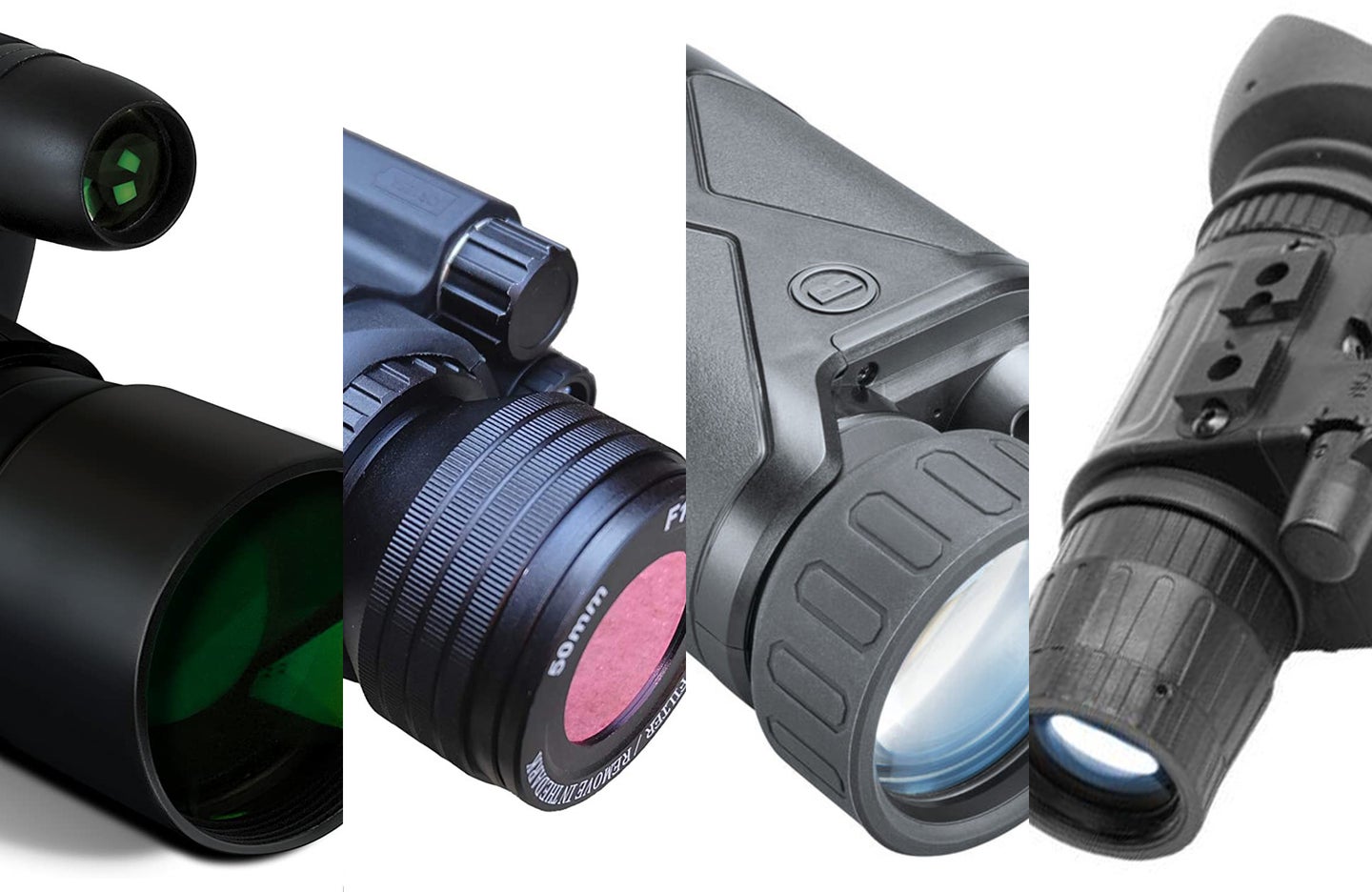
When the going gets dark, all you need is one eye to light up the night.
The post The best night vision monoculars for 2023 appeared first on Popular Photography.
]]>
We may earn revenue from the products available on this page and participate in affiliate programs. Learn more ›
Whether you are looking for wildlife, making sure no one approaches your property, or just want to be able to know what’s out ahead of you in the night, reliable night vision monoculars can light up an otherwise dark world.
Night vision allows you to see in the dark, and as the name might have you realize, a monocular does this for you using just one eye. Monoculars are preferred by some as the simpler monocular structure often comes at a lower price and higher quality as you don’t need to double the optics and technology within. Some will prefer night vision binoculars, though, as using just a single eye can limit your field of vision and cause some eye strain. Whatever you choose, here are the best night vision monoculars and some things to consider before you buy.
- Best overall: Luna Optics 6-36X50mm Digital G3 Day & Night Vision Monocular
- Best value: Bushnell Equinox Z2
- Best budget: Night Owl NOXM50 Night Vision Monocular
- Best under $100: Solomark Night-Vision Monocular
- Best for professionals: ATN NVM14-4
- Best for beginners: Stealth Cam Digital Night Vision Digital Monocular
Things to consider when shopping for a night vision monocular
Weight
If you are carrying this into the backcountry while hiking, hunting, or doing anything else that will have your belongings on your back, weight is an important consideration. Lighter tools are easier to carry, though that weight savings often comes at a cost.
Size
Similar to weight, the size of your night vision device will dictate how likely you are to bring it with you. Smaller, more compact devices are easier to justify in the cramped space of a backpack or camp bag. Though, if you will use these at home or from your vehicle, this may not be as big of a consideration.
Magnification power
Night vision can not only light up the night, often it can magnify your view like a pair of binoculars to give you better view off in the distance. Greater magnification often comes at a higher cost, but consider picture quality as well. Some devices will offer digital magnification along with optic magnification, but just like expanding your fingers to zoom in on a phone photo, this often comes with a degradation of the image quality.
Battery power
Seeing at night requires power, and you won’t be plugging these devices into the wall. Some night vision devices run on disposable batteries while others have built-in rechargeable batteries. This can affect prices as well as run time. Some prefer the ease of recharging, while others like to have their night vision run on disposable batteries so that they can easily bring an extra set off-grid when they are unlikely to return to a charging location before the batteries die.
Objective lens
Objective lens, or effective diameter, is the diameter of the monocular lens. A larger lens will collect more light, and enhance the clarity and brightness of your image.
Analog vs. digital night vision
Most night vision relies on infrared light outside our visible light spectrum. Analog night vision uses an image intensification tube to amplify the light in an image. Using your analog night vision in bright conditions can ruin the sensitive technology within the device, whereas digital night vision since it just converts the light to electrical signals, will be unaffected. Digital devices give sharper, clearer images but are often far more expensive.
Digital night vision converts the infrared light to electronic signals. These often come in three to four generations, generation 1, 2, 3, and 4 with the quality and brightness of the image increasing in each generation. These images are much sharper, and clearer, though they are often more expensive.
You may also find thermal night vision which creates images from the heat these objects let off, though, since this technology is more advanced, it is usually far more expensive than either analog or digital infrared night vision.
Durability
Consider how you will use your night vision. If it will stay in the car or on the porch, something cheaper can work but if you know you’ll be putting it through the ringer, adding features like a waterproof body can be well worth the cost.
Cost
As with any purchase, cost will likely be a main factor. Consider the things you need, like magnification power, features, and battery life as you make your purchase to get the most out of your money. Entry levels can be found under or near $100 while it’s easy to spend deep into the thousands.
Best night vision monoculars: Ratings & reviews
Best overall: Luna Optics 6-36X50mm Digital G3 Day & Night Vision Monocular
Luna Optics
Why it made the cut: If you want excellent image performance, then this is the model to get.
Specs
- Type of vision: Digital
- Magnification power: up to 36x
- Battery type: Rechargeable
- Weight: 1.1 pounds
- Dimension:180 x 80 x 60 mm
Pros
- High quality image
- Long effective range
- Great connectivity
Cons
- Price not for beginners
For the user who wants great range and incredible performance, this is a spectacular night vision monocular that will meet most of your needs at a price that, while not cheap, won’t entirely break the bank.
Many will love the exceedingly clear 12.2 MP images and 1080p 60fps footage through the 50mm objective lens that will give you a clear image of the night thanks to this G3 digital night vision. And that comes with magnification anywhere from 6X to 36X. The included IR illuminator also means you can use it in complete darkness.
You can save these images or stream them directly to a device like a tv or cell phone. If you want improved stability for images at the limit of the 400m range, this device is also equipped with the hardware necessary to connect it directly to a tripod. The device is also rechargeable with a 3.5-hour battery life, so you don’t need to worry about bringing extra batteries out into the field with you.
While it is not fully waterproof, it is water resistant and ready to operate at extreme temperatures from 14°F to 122°F. And if you do push the limits, this device also has a one-year warranty.
Best value: Bushnell Equinox Z2
Bushnell
Why it made the cut: You can save some money and still get powerful performance if you don’t need a ton of features.
Specs
- Type of vision: Digital
- Magnification power: 6x
- Battery type: 4 AA
- Weight: 1.7 pounds
- Dimension: 191 x 98 x 64 mm
Pros
- Value for the price
- Wi-fi enabled
- Waterproof
Cons
- Relatively heavy
- Feature light
This affordable monocular by Bushnell is light on features but makes up for it with simple operating, connectivity, and clear images. The waterproof body makes it a great option for big adventures and small.
This digital monocular night vision gives a clear view from up to 1000 feet away. How clear? The monocular is capable of 1080p quality video during the day or night, as you can use the 6X magnification whether it is daytime or nighttime. And in complete darkness, the IR illuminator will still let you see.
The image is clear thanks to its 55mm objective lens that provides little distortion to the edge of the image. While it does not have a ton of features, it is wifi enabled and can sink saved video to a phone, computer, or tablet, and can also live stream directly to a cell phone while in use to give you and others the same view of the night.
Best budget: Night Owl NOXM50 Night Vision Monocular
Night Owl
Why it made the cut: This cheap option performs above its price tag.
Specs
- Type of vision: Digital
- Magnification power: 5X
- Battery type: 3-volt Type-123
- Weight: 1 pound
- Dimension: 197 x 96 x 63 mm
Pros
- Affordable Gen 1 performance
- Long battery life
Cons
- Non-standard battery not included
- Some trouble focusing
- No warranty
This is a great value for the user looking for good performance at a great value.
The 50mm objective lens provides a satisfying image with 5X magnification, thanks in part to the real glass optics used in this G1 night vision. Some other, lesser quality monoculars opt for plastic lenses that can distort an image.
Of course, at this price, this night vision is not perfect as the image can distort some at the edges and the lack of an eye cup on the end of it means that some light will escape, and the image might suffer. If there is total darkness, you’ll still be able to see thanks to a built-in IR illuminator.
The image is adjustable to match your eyesight, but finding a perfect focus can still be a bit difficult. The soft-touch rubberized finish adds some durability and impact resistance.
Best under $100: Solomark Night-Vision Monocular
SOLOMARK
Why it made the cut: Its price puts it firmly in impulse purchase territory.
Specs
- Type of vision: Digital
- Magnification power: 2x
- Battery type: 4 AA
- Weight: 11.5 ounces
- Dimension: 147 x 101 x 47 mm
Pros
- Good battery life
- Good warranty
- Less than $100
Cons
- Image sufferers when zoomed
- Small viewing angle
For someone looking to spend very little money but still get some night vision capabilities, this might be the perfect fit, coming in impressively under $100.
It will light up the night, even in total darkness, with its IR illuminator that has several levels of illumination to help you find the proper brightness. But the performance is less than many of its competitors. It has a lower-quality image and is only effective at 328 feet. While it does have four zoom levels, they top out at 2x, and image quality will suffer as you use that zoom. At any distance, it also has a smaller viewing window than most, so your sight picture will be smaller than some of its competitors.
Even still, this compact and lightweight digital night vision will give you a view into the dark and has handy features like an included SD memory card, carrying case, and ability to wire it (not wireless) to other viewing screens. While it runs on AA batteries, they do provide a good battery life. On top of that, it comes with a two-year limited warranty.
Best for professionals: ATN NVM14-4
ATN
Why it made the cut: It’s bright, powerful, and packed with features that pro users require.
Specs
- Type of vision: Digital
- Magnification power: 1X
- Battery type: CR123A or AA battery
- Weight: 11.3 ounces
- Dimension:119 x 48 x 69 mm
Pros
- Auto brightness adjusting
- Headgear and gun mountable
Cons
- A whole lot of money
- Heavier than most
This is a top-of-the-line night vision for professional use, and it comes with a professional price tag.
This night vision has a truly cutting-edge G4 digital optic with a 27mm objective lens diameter that will clearly light up the night with an impressively wide field of vision. It also comes with a slew of great features to optimize performance, including automatic brightness adjustment to make sure you are always getting your most clear image, and excessive light won’t do any damage to the technology. And if it is completely dark, the included IR illuminator, called ATN’s Total Darkness Technology, will allow you to see when the lights are down.
The device is also built to professional-grade and completely waterproof and can work in extreme temperatures from -40°F to 131°F. It can also be used in hand, mounted to a helmet or a gun, and will work in combination with your scopes or sight. On top of that, it will work for 50 hours on a single battery.
For the highest-end user, it has unparalleled performance with a two-year warranty. Though, if you need magnification, this is not your device.
Best for beginners: Stealth Cam Digital Night Vision Digital Monocular
Stealth Cam
Why it made the cut: A simple but effective night vision monocular design accompanies a low price tag, which makes this appealing to beginners.
Specs
- Type of vision: Digital
- Magnification power: 9X
- Battery type: 4 AA
- Weight: 15.9 ounces
- Dimension: 177 x 64 x 152 mm
Pros
- Bargain price
- Powerful digital zoom
- Carrying pouch included
Cons
- Not waterproof
- Only 720p footage
- Narrow objective lens
This entry-level night vision monocular will let you see in the night, but it prioritizes affordability over performance and some of the features of more robust monoculars. Though, it still has an IR illuminator for use in complete darkness.
As a beginner-focused device, it provides recordable video night vision footage in 720p, a resolution that may disappoint some of the more detail-focused users, like those trying to identify wildlife at night, especially when viewed through the relatively narrow 20mm objective lens. While it does offer 9x zoom, this may include some image degradation, especially as this night vision works best at distances of 400 feet or less. The digital night vision does allow you to use the magnification during the day as well, though.
While it is not waterproof, it does include a high-impact housing with a no-slip grip which should help you keep it out of any lakes or streams. And when you are not using it, you can store it in the included carrying pouch.
FAQs
Q: How much does night vision cost?
Night vision can run the gambit of costs, from less than $100 to deep into the thousands of dollars. Of course, like with most things in life, you’ll likely get what you pay for. While cheap night vision may give you some visibility, they will likely lack clarity, detail, and durability. Decide what you need, and invest in the proper strengths.
Q: Is night vision worth it?
It depends on your use. If you need night vision for frequent use and have a few use cases you will use it for, then very likely. If you are just curious about the technology, try starting with a cheaper option until you need an upgraded model.
Q: How far can you see with night vision?
Range depends both on how good the magnification is and how good the night vision is at capturing light. Most will work well in short range, while some will work up to 1,000 feet away.
Q: Can you stargaze with night vision?
Night vision amplifies light in the night, so pointing it at the sky will allow you to notice stars and features, like the Milky Way, that may otherwise be impossible to see.
Final thoughts on night vision monoculars
For those looking to have a better view at night, for camping, fishing, hunting, security, star gazing, or anything else, night vision gives visibility where visible light can’t. Night vision monoculars are great options for many as the technology comes in a more affordable package than night vision binoculars, with similar to better performance.
Methodology: How we picked the best night vision monoculars
We scoured the internet to find the best online resources, experts, expert reviews, consumer reviews and recommendations for night vision monoculars for all situations. From there, we collected an extensive list of some of our favorites and compared them on a number of essential metrics, including cost, coverage, portability, durability, features, connectivity, and ease of use.
We then worked through each monocular night vision to find its strength and weaknesses as well as crucial metrics to help you find the night vision that will work best for you and your needs, wherever you are in the world.
The post The best night vision monoculars for 2023 appeared first on Popular Photography.
Articles may contain affiliate links which enable us to share in the revenue of any purchases made.
]]>